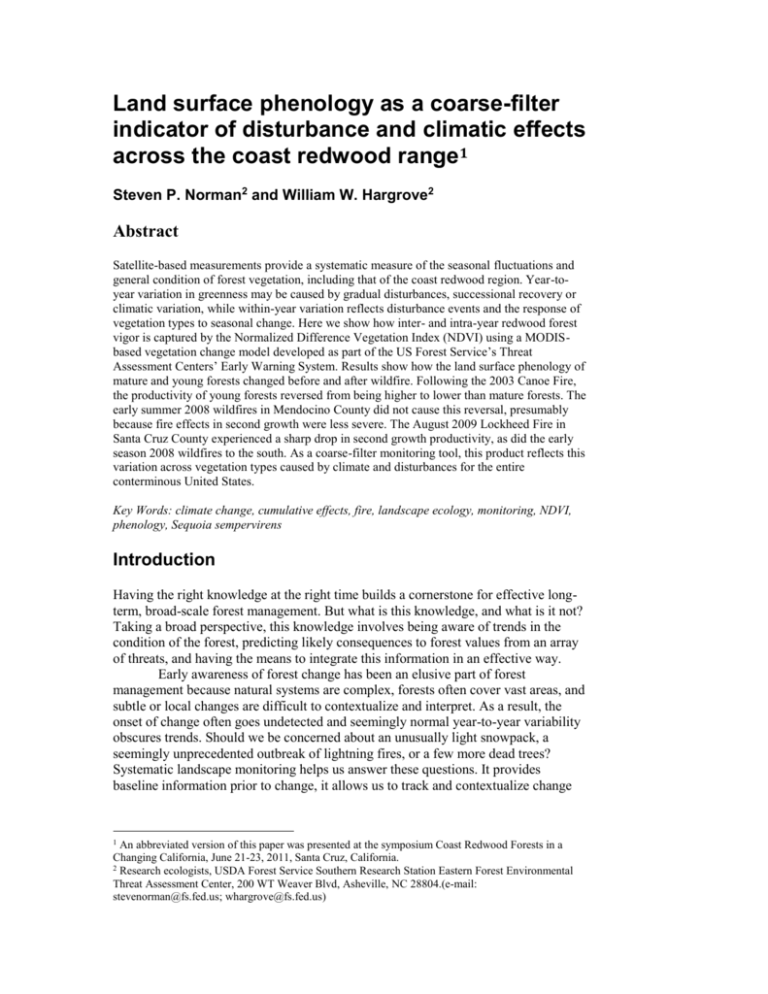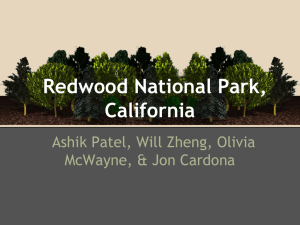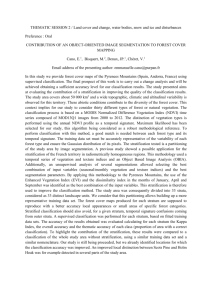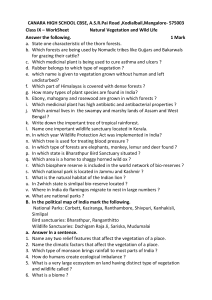Here*s the Title1
advertisement

Land surface phenology as a coarse-filter indicator of disturbance and climatic effects across the coast redwood range1 Steven P. Norman2 and William W. Hargrove2 Abstract Satellite-based measurements provide a systematic measure of the seasonal fluctuations and general condition of forest vegetation, including that of the coast redwood region. Year-toyear variation in greenness may be caused by gradual disturbances, successional recovery or climatic variation, while within-year variation reflects disturbance events and the response of vegetation types to seasonal change. Here we show how inter- and intra-year redwood forest vigor is captured by the Normalized Difference Vegetation Index (NDVI) using a MODISbased vegetation change model developed as part of the US Forest Service’s Threat Assessment Centers’ Early Warning System. Results show how the land surface phenology of mature and young forests changed before and after wildfire. Following the 2003 Canoe Fire, the productivity of young forests reversed from being higher to lower than mature forests. The early summer 2008 wildfires in Mendocino County did not cause this reversal, presumably because fire effects in second growth were less severe. The August 2009 Lockheed Fire in Santa Cruz County experienced a sharp drop in second growth productivity, as did the early season 2008 wildfires to the south. As a coarse-filter monitoring tool, this product reflects this variation across vegetation types caused by climate and disturbances for the entire conterminous United States. Key Words: climate change, cumulative effects, fire, landscape ecology, monitoring, NDVI, phenology, Sequoia sempervirens Introduction Having the right knowledge at the right time builds a cornerstone for effective longterm, broad-scale forest management. But what is this knowledge, and what is it not? Taking a broad perspective, this knowledge involves being aware of trends in the condition of the forest, predicting likely consequences to forest values from an array of threats, and having the means to integrate this information in an effective way. Early awareness of forest change has been an elusive part of forest management because natural systems are complex, forests often cover vast areas, and subtle or local changes are difficult to contextualize and interpret. As a result, the onset of change often goes undetected and seemingly normal year-to-year variability obscures trends. Should we be concerned about an unusually light snowpack, a seemingly unprecedented outbreak of lightning fires, or a few more dead trees? Systematic landscape monitoring helps us answer these questions. It provides baseline information prior to change, it allows us to track and contextualize change 1 An abbreviated version of this paper was presented at the symposium Coast Redwood Forests in a Changing California, June 21-23, 2011, Santa Cruz, California. 2 Research ecologists, USDA Forest Service Southern Research Station Eastern Forest Environmental Threat Assessment Center, 200 WT Weaver Blvd, Asheville, NC 28804.(e-mail: stevenorman@fs.fed.us; whargrove@fs.fed.us) GENERAL TECHNICAL REPORT PSW-GTR-19x after it occurs. Both help us address the effectiveness of broad management strategies. Monitoring from space provides a coarse-filter way to detect departure from past conditions caused by a range of stressors, yet despite the general availability of raw satellite imagery, processing and data analysis has been too time consuming to provide a near-real time monitoring tool for broad landscapes. That obstacle is falling as formal change-detection systems are being developed for the United States (Hargrove et al. 2008). A second challenge of space-based monitoring is that it can be difficult to translate changes observed from above with the things we actually care about on the ground. That translation involves not just monitoring, but an interpretative assessment. How well can space-based monitoring capture the overall condition of the coast redwood forest? During recent decades, notable changes in the coast redwood forest have resulted from land use conversion for development, logging, wildfire and Sudden Oak Death. Looking ahead, monitoring needs to include not just the effects of these factors individually, but how they collectively interact with each other and with changes in climate. The dual purposes of this paper are to (1) demonstrate how space-based monitoring technology can track forest changes across the coast redwood region, and (2) to provide a coarse-filter assessment of the impacts of recent wildfires and climate variability across the coast redwood range. Methods To describe vegetation within and among years, we used an 11-year dataset of the Normalized Difference Vegetation Index (NDVI) developed for the National Early Warning detection system (Hargrove et al. 2009). This MODIS-derived product provides NDVI values for the conterminous United States using a moving three-week window, delivered at eight-day intervals at a resolution of 232m. NDVI is a measure of live green vegetation calculated from two bands of reflected solar radiation that plants have evolved to preferentially absorb for photosynthesis (red wavelengths) and reflect (the near infrared). In the West, NDVI values for dense coastal evergreen forest typically fall between 0.8 and 0.9, while open forests with deciduous or grass understories fluctuate seasonally and typically range from 0.5 to 0.8. This moderate resolution, high frequency NDVI time series has sufficient resolution to capture these seasonal dynamics, in addition to sudden changes in vegetation vigor caused by disturbance-associated stress (Hargrove et al. 2009). Digital maps of wildfire boundaries and coast redwood vegetation were downloaded from the California Department of Forestry and Fire Protection (http://frap.cdf.ca.gov/, Fox (1988)). Coast redwood vegetation was mapped from 1:130,000-scale 1986 color infrared aerial photos supplemented with NASA and USGS aerial photos in the southern range with a minimum mapping unit of 40 acres. While this mapping effort targeted redwood vegetation in particular and provides coarse-vegetation polygons consistent with the needs of MODIS-resolution data, the product varies in accuracy. Forest age is not always as mapped, particularly in the south, and in the north, logging between the mid-1980s and 2000 may further affect results on private lands. Wildfires in coast redwood forest were selected that fell within a temporal window (2001-2009) that would allow comparison of pre- and post-fire NDVI conditions. Multiple fires that initiated during a 2008 lightning storm were separated into a north and south group. The 2003 Canoe fire in Humboldt Land surface phenology as a coarse filter indicator of disturbance and climate effects across the coast redwood range Redwoods State Park and the 2009 Lockheed Fire in Santa Cruz County provided two additional fire analysis units for examination. In total, the portion of 19 fires were analyzed that included redwood or redwood-associated forest types (Table 1). The midpoints of each 231m MODIS pixel that fell within the 125m-buffered edge of these fire boundaries were intersected with each eight-day raster for the 2000 to 2010 period using GIS. This resulted in four 506 column tables with one table for each of the four county-year based fire analysis units (Table 1). Table 1—Fires grouped by county-year analysis unit County Humboldt Mendocino Santa Cruz Monterey and Santa Cruz Fire name Canoe Middle Lost Pipe Hardy Creek Indian Table Mountain Navarro Williams Orr Series Horse Low Gap Cowshed Cliff Ridge Sugarloaf Lockheed Basin Complex Trabing Martin White Hurst Active fire dates 09-03 to 10-06 2003 06-23 to 07-15 2008 07-04 to 07-10 2008 06-21 to 07-11 2008 06-26 to 07-12 2008 06-21 to 06-26 2008 06-21 to 06-26 2008 06-21 to 06-27 2008 07-04 to 07-12 2008 06-28 to 07-04 2008 07-04 to 07-15 2008 06-21 to 07-15 2008 06-22 to 07-12 2008 06-21 to 07-09 2008 08-12 to 08-23 2009 06-21 to 07-27 2008 06-20 to 06-22 2008 06-11 to 06-16 2008 06-21 to 06-23 2008 Fire area (GIS acres) 11,044 2,067 1,187 5,354 327 2,096 1,853 445 3,416 576 1,347 4,466 4,658 6,928 7,783 163,606 594 483 256 The midpoint of each MODIS pixel was also intersected with the map of coast redwood vegetation (Fox 1988) to help distinguish mature and young forest types. While this did not always capture the dominant vegetation type within a given MODIS pixel, it provided an efficient means of data extraction. Both the pixel purity and undocumented logging-associated change may reduce any difference among vegetation types. Pixels were then averaged for each fire analysis unit across the 506step NDVI time series to see how vegetation types responded to seasonal dynamics and fire events. To provide a more inclusive assessment of the condition and trends in NDVI across the coast redwood region, a second analysis was conducted using an elevenyear assessment of NDVI for the entire coast redwood range as delimited by Fox (1988). Four eight-day periods in January and four eight-day periods in August were averaged, by year, for mature redwood and young redwood-plantation vegetation types. This analysis included 104,227 pixels to the north and 16,592 pixels to the south of San Francisco. Pixel midpoints that fell on associated vegetation types dominated by hardwood and Douglas fir were excluded. Yearly NDVI values for January and August were graphed for all pixels across the range, and then just for those pixels that did not burn during the 11-year analysis period, in order to better distinguish fire effects from climate effects. Results Coast redwood forests exhibited notable variation in NDVI during and among years. GENERAL TECHNICAL REPORT PSW-GTR-19x For forests that burned, both pre-fire and post-fire greenness decreased toward the south, but the reduction attributable to fire was not consistent among vegetation types (Table 2). The severity of the reduction in NDVI with fire sharply increased toward the south, but this reduction involved complex local differences among vegetation types. In the two 2008 fire analysis units, mature forests declined more than young forests, although this was a marginal difference compared to the extreme declines observed between young and mature forests in the 2003 Canoe fire and 2009 Lockheed fires. After the Canoe and Lockheed events, the high pre-fire NDVI of young forests reversed relative to mature forests (fig. 1A, 1C). This reversal did not occur after the 2008 events. Young forests remained greener than mature forests in the north while remaining less green than mature forests in the south (fig. 1B, 1D). Table 2—Change in mean annual NDVI for coast redwood forests that burned from the prefire year to the post-fire year Forest type Pre-fire NDVI Post-fire NDVI 2003 Canoe Fire (Humboldt Co.) (n=692) Mature .86 .79 Young .86 .77 Overall .86 .78 2008 Mendocino County Fires (n=1938) Mature .83 .76 Young .85 .78 Overall .85 .76 2009 Lockheed Fire (Santa Cruz County) (n=351) Mature .75 .72 Young .82 .69 Overall .82 .69 2008 Santa Cruz- Monterey County Fires (n=830) Mature .78 .63 Young .72 .59 Overall .80 .65 Percent drop 7.9 10.9 9.8 8.9 8.7 8.7 4.8 15.8 15.1 20.3 17.7 19.5 Figure 1—An eleven-year, 8-day time series of the Normalized Difference Vegetation Index (NDVI) for four fire analysis units across the coast redwood range. A: 2003 Canoe Fire, B: 2008 Mendocino fires, C: 2009 Lockheed Fire, D: 2008 Santa Cruz-Monterey County fires. A: 2003 Canoe Fire Land surface phenology as a coarse filter indicator of disturbance and climate effects across the coast redwood range B: 2008 Mendocino fires C: 2009 Lockheed Fire D: 2008 Santa Cruz-Monterey County fires GENERAL TECHNICAL REPORT PSW-GTR-19x Across the entire coast redwood range, NDVI varied among seasons, years, and vegetation types from 2000 to 2010 (fig. 2). Mature forests south of San Francisco were less green than mature forests to the north, while young forests were less distinguishable by latitude. In January, young forests were consistently greener than nearby mature forests, but, by August, this relationship reverses in the north. Figure 2--Trends in mean January and August NDVI for mature and young coast redwood forests north and south of San Francisco, California showing the forest’s range-wide status (top row) and just those areas that did not burn during the 2000 to 2010 period (bottom row). The disproportionate effects of recent fires across the coast redwood range are apparent across the two rows of graphs. Given the larger portion of coast redwood forest in the north that did not burn, the effects of fire on regional NDVI are indistinguishable there, but not so in the south. A larger portion of mature forest in the south has burned and this depressed the NDVI of mature forests there. Note that January NDVI declines across all vegetation types, even after burned areas are removed. In August, this decline is only evident in the south. Discussion Change in NDVI provides a useful mechanism for monitoring the vigor of coast redwood forests at moderate resolution and in near-real time. In areas without disturbance, changes in monthly NDVI reflect seasonal variation in forest greenness related to phenology and cover types, while year-to-year differences reflect variation in climate (Hargrove et al. 2009). The winter peak in greenness and the late summer low generally correspond to gross seasonal vegetation productivity within this Mediterranean climate, but (with the exception of the Lockheed fire area, Fig. 1C), this NDVI peak precedes the maximum period of cambial activity (spring to early summer) by several months. This phenological pattern of winter maximum, summerminimum contrasts with the pattern of spring greenup and autumnal brown down that typifies other temperate climates that support deciduous forest cover. Land surface phenology as a coarse filter indicator of disturbance and climate effects across the coast redwood range The greater decline in greenness after fire in the south (Table 2) may relate to latitudinal differences in fire weather (i.e., temperature and fuel moisture) or to differences in the distribution of vegetation types across slopes caused by differences in climate or history. In the south, mature forests are restricted to narrow riparian areas, so that the area in mature forest constitutes a small portion of the landscape. This greater likelihood of a mixed pixel effect in the south may explain the rapid increase in mature forest NDVI after the 2008 fires in Santa Cruz and Monterey Counties (Figure 1D). The vegetation classification in the south is also of questionable accuracy as the area burned by the Lockheed fire has less mature forest than was mapped. The effects of wildfire on the productivity of mature and young forests are generally consistent with the mixed severity behavior expected from wildfires that burn across complex topographies within the region (Lorimer et al. 2009). Apart from impacts from logging, older forests tend to naturally occur in protected portions of the landscape where fire is less likely to be severe. Field observations and casual examinations of aerial imagery from before and after wildfire support this explanation. However, note that the reduction in young forest vigor after the 2008 Mendocino fires paralleled that of mature forest; that is, it did not decline more than mature forest as seen after the Canoe Fire (Fig. 1A, 1B). This may be because the 2008 fires burned earlier in the growing season when fuel moistures were higher and fire behavior and severity were accordingly reduced. Seasonal conditions associated with the winter-wet, summer-dry climate explain the marked and consistent differences between January and August NDVI, but year-to-year climate variation does not consistently align with annual changes in forest vigor (Fig. 2, Fig. 3). January 2006 was the least droughty of the eleven years as measured by the Palmer Drought Index both north and south of San Francisco, and this month experienced a decline in NDVI. However January 2003, an El Niño winter, was also non-droughty in the north, yet NDVI values peaked. Variation in January’s NDVI is not readily explained by monthly drought. In summer, the peak wetness of August 2005 corresponds to maximum NDVI across vegetation types, both in the north and south. However, droughty Augusts were not consistently associated with low NDVI values, particularly in 2001 and 2009. However, the years 2002 and 2008 experienced both dry conditions and low NDVI values in August. Figure 3—Variation in the Palmer Drought Severity Index (PDSI) for climate divisions 401 (north of San Francisco) and 402 (south), 2000 to 2010 (www.ncdc.noaa.gov). This complex effect of moisture stress on NDVI from January to August and inconsistent effects among years suggest that predicting how coast redwood is likely to respond to climate change is difficult. In as much as variation in NDVI can be used GENERAL TECHNICAL REPORT PSW-GTR-19x as a surrogate for productivity and as a predictor of vigor under a changing climate, coast redwood viability may be maximized by cool-wet summers. Such summer conditions are less likely to be associated with wildfire, which has a profound potential for eroding forest productivity far more than does interannual climate variability, as shown by this research. Across much of the coast redwood range, cool summers generally depend on the frequency of fog-stratus cover, which is sensitive to climate variation. Conclusion As a coarse-filter tool for monitoring vegetation change, NDVI time series provide insights into the seasonal and year-to-year dynamics of coast redwood vegetation. The vigor of this evergreen forest responds to changes in climate and disturbance. In the north, forests are less affected by recent wildfires due to the greater cover of forest there and less area burned. Coast redwood forests in the south are already limited by the drier climate and ownership history. The decline in mature forest vigor after fire in both the north and the south is of great management concern, as these forests were historically resistant to fire that burned at high to moderate frequencies (Lorimer et al. 2009). If these patterns of disturbance and recovery continue, active fuels management may be necessary to restore resiliency to high-value stands. As baseline conditions may reflect decades of fire exclusion and ingrowth, the landscape patterns of disturbance and recovery from remote sensing must be paired with ground-level monitoring to ensure that objectives are being met. This forest monitoring tool reveals not just where change takes place at moderate spatial resolution, but the magnitude and context of that change. Climate effects on the vigor of coast redwood vegetation are complex, but year-to-year variation in NDVI provides context for the magnitude of change caused by disturbances, such as wildfire. As this forest continues to change in coming years, such tools provide a way to monitor the cumulative effects of climate change and disturbances across and beyond the coast redwood range. Acknowledgements J. Spruce helped develop the datasets used and W. Christie assisted with analysis. References Fox, L. 1988. A classification, map, and volume estimate for the coast redwood forest in California. California Department of Forestry and Fire Protection. Available online at: http://frap.cdf.ca.gov/. Hargrove, W.W.; Spruce, J.P.; Gasser, G.E.; Hoffman, F.M. 2009. Toward a national early warning system for forest disturbances using remotely sensed canopy phenology. Photogrammetric Engineering and Remote Sensing October: 1150-1156. Lorimer, C.G.; Porter, D.G.; Madej, M.A.; Stuart, J.D.; Veirs, S.D.; Norman, S.P.; OHara, K.L; Libby, W.J. 2009. Presettlement and modern disturbance regimes in coast redwood forests: Implications for the conservation of old-growth stands. Forest Ecology and Management 258:1038-1054.





